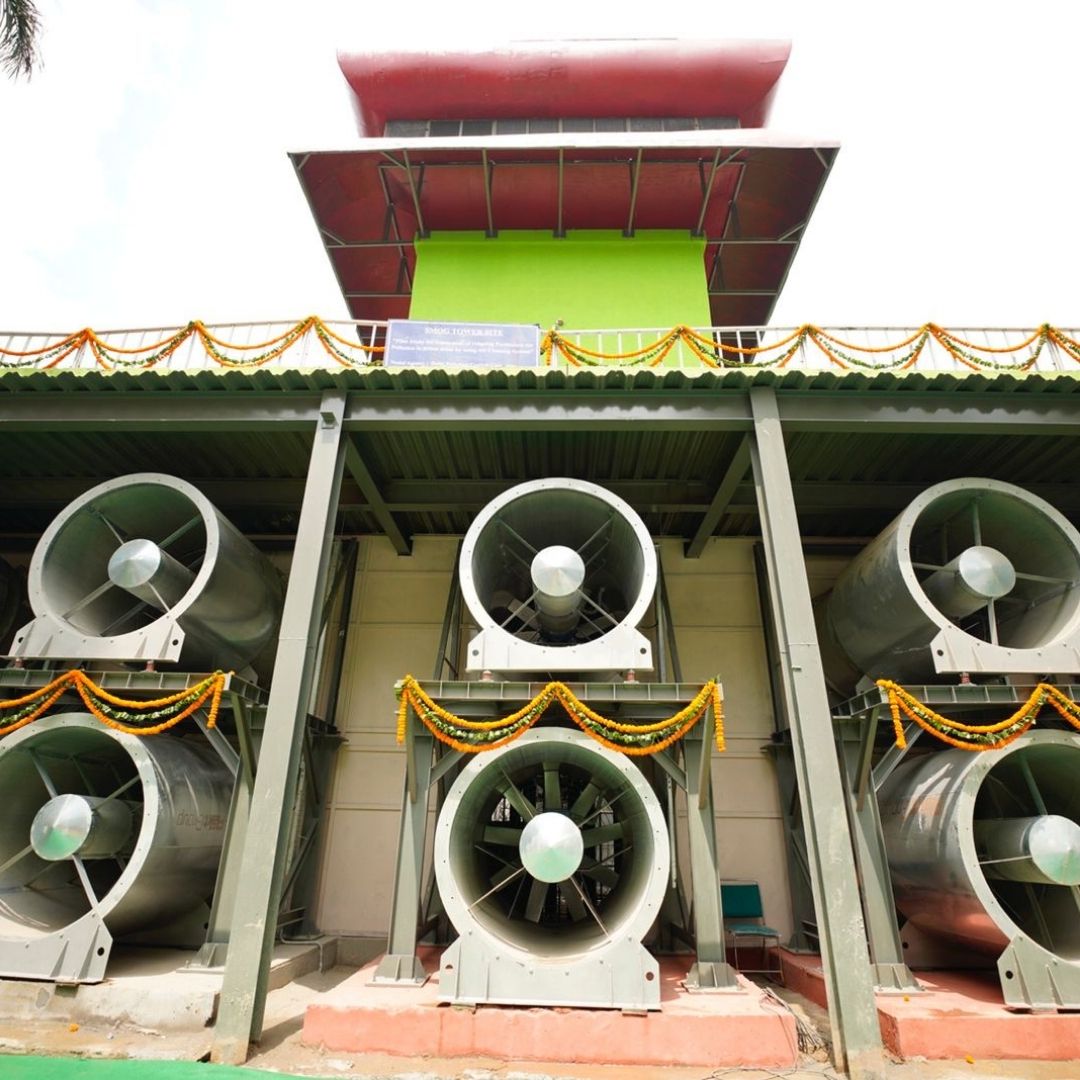
Image Credits: Twitter/Arvind Kejriwal
Delhi's Fight Against Pollution: All You Need To Know About India's First Smog Tower
Writer: Tashafi Nazir
For most people, journalism sounds hectic and chaotic. For her, it's a passion she has been chasing for years. With an extensive media background, Tashafi believes in putting efforts on presenting a simple incident in the most interesting way.
Delhi, 24 Aug 2021 12:42 PM GMT
Editor : Ankita Singh |
A literature lover who likes delving deeper into a wide range of societal issues and expresses her opinions about the same. Keeps looking for best-read recommendations while enjoying her coffee and tea.
Creatives : Tashafi Nazir
For most people, journalism sounds hectic and chaotic. For her, it's a passion she has been chasing for years. With an extensive media background, Tashafi believes in putting efforts on presenting a simple incident in the most interesting way.
Estimated at a cost of Rs 20 crore, the experimental set up is supposed to purify air within a radius of 1 km around the structure at a rate of about 1,000 cubic metres of air per second.
In a bid to combat the rising air pollution in the national capital, Delhi, on Monday, 23rd August, got its own 'smog tower' at Baba Kharak Singh Marg in Connaught Place. The tower was inaugurated by Chief Minister Arvind Kejriwal ahead of the infamous smog season resulting due to the burning of crop residue by farmers. Estimated at a cost of ₹ 20 crore, the experimental set-up is supposed to purify air within a radius of 1 km around the structure at a rate of about 1,000 cubic metres of air per second.
Inaugurating the much-anticipated facility, Kejriwal said that the state government would develop more such towers if it remains successful.
"Congratulations Delhi. In the war against pollution, the country's first smog tower has been started in Delhi. This smog tower made of American technology will reduce the amount of pollution in the air.
If the results of this project started on a pilot basis are good, then more such smog towers will be installed all over Delhi," he posted on his Twitter handle along with the pictures.
What Is Smog Tower?
Smog towers are defined as large-scale air purifiers to minimise the levels of air pollution. Multiple layers of air filters are fitted at the base to suck the air. After the filters suck the polluted air, it gets purified before being circulated again in the atmosphere. They work on the principle of HEPA filtration technology to weed out PM2.5 particles.
Such methods are proven to be well established scientifically and used widely for purifying indoor oxygen where the exchange with the outdoor air is more petite. Dutch artist Daan Roosegaarde built the first prototype of smog tower in 2017 in China's Beijing. It was built as a demonstration that converts the carbon in filtered particles into diamonds.
Components Of Delhi's Smog Tower
The height of the structure is 24 m, which is almost equivalent to an 8-storey building. It is an 18-metre concrete structure, topped by a 6-metre-high canopy. It has 40 fans on its base, 10 on each side.
Each fan has the capacity to discharge 25 cubic metres per second of air, so the whole tower can discharge up to 1,000 cubic metres per second. There are 5,000 filters inside the tower in two layers, which have been imported from the United States.
How Does It Function?
The 'downdraft air cleaning system' is used by the experimental structure. The system is developed by the University of Minnesota," Anwar Ali Khan, senior environmental engineer, Delhi Pollution Control Committee, said while speaking to The Indian Express. Khan is also in charge of the much-anticipated project. Both American university and IIT-Bombay have collaborated with each other to replicate the technology. The commercial arm of Tata Projects Limited has implemented it.
At the height of 24 m, the polluted air is sucked and filtered air is released at the bottom of the structure, which is almost 10 m high from the ground level. After the fans at the bottom of the structure operate, the air is sucked due to the negative pressure from the top. The macro layer then traps particles of 10 microns or larger, whereas the microlayer filters out those having size of about 0.3 microns.
The air quality will be monitored by an automated Supervisory Control and Data Acquisition (SCADA) system installed in the tower. Besides temperature and humidity, it will also measure levels of PM2.5 and PM10, which will be displayed on a board on top of the tower.
Project In Compliance With The Supreme Court Order
In 2019, the apex court had directed the Central Pollution Control Board (CPCB) and Arvind Kejriwal led the government to come up with smog towers in the city to keep air pollution at bay. The court was hearing about air pollution in Delhi that resulted from stubble-burning in Punjab and adjoining states of Uttar Pradesh and Haryana. The proposal was then submitted by IIT-Bombay to the CPCB. The Supreme Court then in January last year asked the concerned bodies to install two such towers by April as a pilot project in the national capital.
Besides the one in Connaught Place, the second tower is being constructed at Anand Vihar and is in its final phase.
Are The Smog Towers Effective?
According to the experts, there isn't much evidence suggesting that the smog towers are very effective. Anumita Roychowdhury, executive director of research and advocacy at the Centre for Science and Environment, believes that there is no precise data available yet that stresses that these structures have helped combat the rising air pollution levels of an entire city. "How do you filter air in a dynamic scenario, when it is not a confined area?" The Indian Express quoted her as saying.
Other Countries To Use It
The Netherlands and South Korea are currently using smog towers but on a small scale. However, the only operational smog tower across the globe is a 60-metre high tower in Xian, the capital of northwest China's Shaanxi province. The experts and national media have slammed the tower and have termed it as an eyewash and ineffective. The researchers at the Institute of Earth Environment at the Chinese Academy of Sciences are currently testing the structure and said that the average reduction in PM2.5-the fine particles in smog deemed most harmful to health — fell 15 percent during heavy pollution. That's a spoonful from a periphery of not more than 100 metres.
In India, the downdraft method used in the tower is different from the one used in China, where they use an 'updraft' method in a 60-metre smog tower in Xian city. In the updraft method, air is sucked in from near the ground and is pushed in the upward direction by heating and convection. Filtered air is released at the top of the structure.
Also Read: Complaining About Poor Water Quality? Get It Tested On One-Stop Government Portal
 All section
All section














